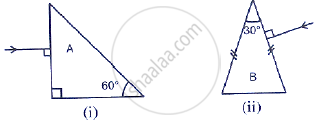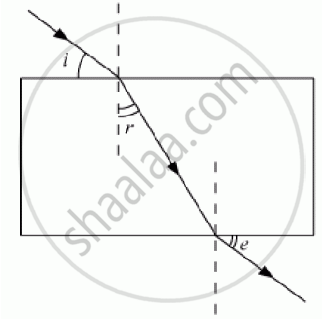Advertisements
Advertisements
प्रश्न
On the basis of the experiment, "To trace the path of a ray of light through a rectangular glass slab", students of a class arrived at which one of the following conclusions?
(A) Angle of incidence is greater than the angle of emergence.
(B) Angle of emergence is smaller than the angle of refraction.
(C) Emergent ray is parallel to the refracted ray.
(D) Incident ray and emergent ray are parallel to each other.
उत्तर
The correct conclusion is that the incident ray and emergent ray are always parallel to each other.
Hence, the correct option is D.
APPEARS IN
संबंधित प्रश्न
Fig 4.31 below shows a light ray of single colour incident normally on two prisms A and B. In each case draw the path of the ray of light as it enters and emerges out of the prism. Mark the angle wherever necessary.

What is meant by the statement the critical angle for diamond is 24°?
“A ray of light incident on a rectangular glass slab immersed in any medium emerges parallel to itself.” Draw labelled ray diagram to justify the statement.
A student traces the path of a ray of white light through a rectangular glass slab and marks, the angles of incidence (∠i) , refraction (∠r) and emergence (∠e) as shown. Which angle or angles has he not marked correctly?

(A) ∠i only
(B) ∠i and ∠r
(C) ∠i and ∠e
(D) ∠r and ∠e
Draw a diagram to show the splitting of white light into its constituent colours.
State the factors on which the angle of deviation depends.
Express the refractive index μ of a medium in terms of the velocity of light.
How does the angle of deviation produced by a prism depend on the angle of incidence of light at the prism surface? Draw a graph to illustrate your answer.
The refractive index of glass with respect to air is 3/2. What is the refractive index of air with respect to glass?
